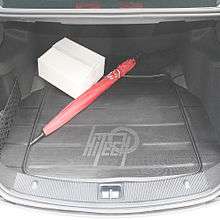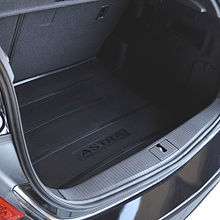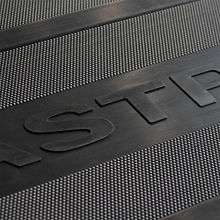Car boot liner




A car boot liner or cargo liner is a synthetic mat designed to protect the automobile boot or trunk against damage from dirt or spills and to pad cargo against abrasion or shock. Specifically, a boot liner shields the vehicle carpet from damage. Boot liners are usually removable so they may be cleaned or replaced.
Types
The standard PVC boot liner is universal in nature and then trimmed to fit by the end user. It is ideally developed for simple shaping and is flat in nature and subsequently offers less protective qualities.
Alternatively there are boot liners made from rubber that are tailor / "custom made" to fit the flat space of a vehicle's specific cargo area. Typically, these mats have a channelled, repeated upper design and raised edges. The top surface design is usually non-slip in nature and helps to prevent spills and liquid leakages occurring in the internal cargo space.
Both universal and "custom" boot liners can be rolled up and removed or replaced if necessary.
TPE or a form of thermoplastic is a common material used in boot liners.
It is favoured by OEM and Aftermarket manufacturers for its speed of production (vacuum formed), light weight, and strength. This material type is rigid enough to withstand heavy cargo loads i.e. it won't fold or crumple as corners are manoeuvred. An additional benefit of TPE is its ability to maintain its basic shape while being removed which helps to keep dirt and spills on the mat [1].
There are also highly tailored boot liners available often made from PVC or Cloth, These liners offer protection for the boot area (floor, sides and back of seats) and are often available in several configurations and colours as specified by the customer. These liners are usually specifically designed for individual car models.[2]
Those wanting to protect all of the interior of the boot (floor, sides and back of seats including the roof lining and bumper bar) can use a heavy duty polyester boot liner. These are designed to be fitted when needed [3] and stored under the seat or in the spare tyre area when not. This type of liner can withstand heavy domestic use and are water resistant (not waterproof). They are not tailored to a specific vehicle and are available in small and large sizes to suit most hatches, wagons, SUVs and 4WD vehicles.
Some boot liners are designed to overlap over the bumper edge to prevent damage during loading. This has been developed also by car manufacturers to offer all-around protection.
Materials
Boot liners are commonly made with several different types of synthetic or natural rubber.
Patent
A patent for a "motor vehicle boot insert" was approved in 1993.[4]
A patent for an "Abstract Receptacle for vehicles" was granted in 2012.[5]
See also